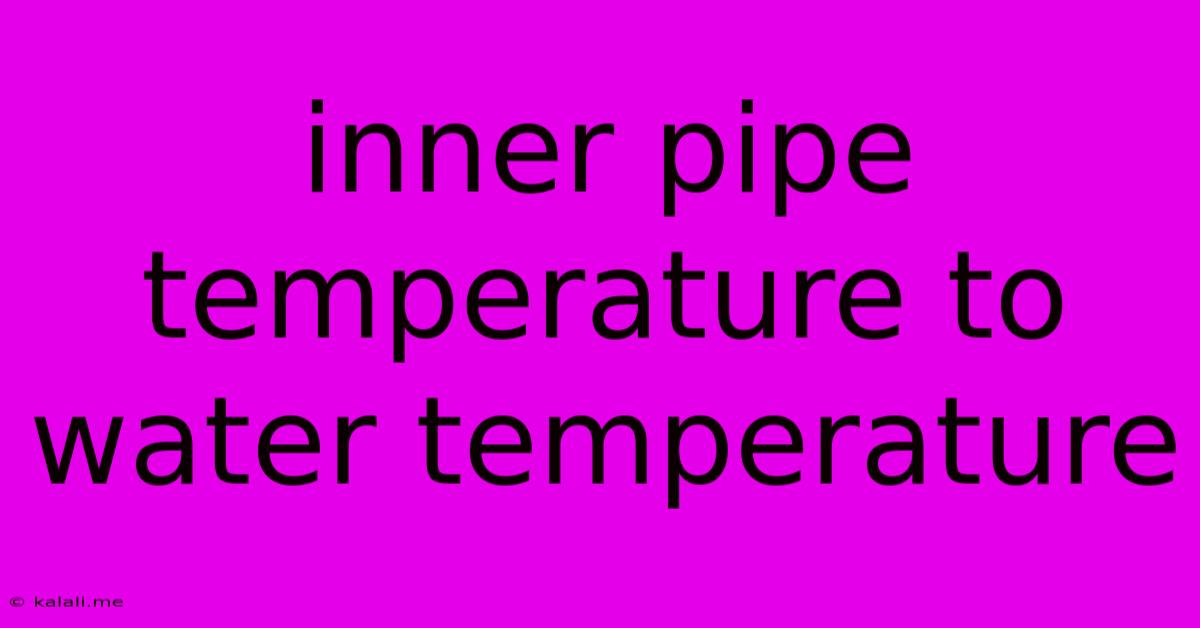Inner Pipe Temperature To Water Temperature
Kalali
Jun 05, 2025 · 3 min read

Table of Contents
Understanding the Relationship Between Inner Pipe Temperature and Water Temperature
This article explores the crucial relationship between the temperature of a pipe's inner surface and the water flowing within it. Understanding this dynamic is vital in various applications, from efficient plumbing design to industrial process control. We'll delve into the factors affecting this temperature difference, practical implications, and methods for measurement and control.
What is the difference between inner pipe temperature and water temperature? The inner pipe temperature reflects the temperature of the pipe's internal surface, while the water temperature represents the bulk temperature of the water flowing through it. These temperatures are rarely identical, and the difference is influenced by several factors including heat transfer, flow rate, pipe material, and insulation. This difference can significantly impact system efficiency and performance.
Factors Affecting the Temperature Difference
Several key factors influence the discrepancy between the inner pipe temperature and the water temperature:
-
Heat Transfer: Heat naturally flows from hotter regions to colder ones. If the water is hotter than the pipe's surroundings, heat will transfer from the water to the pipe, causing the inner pipe temperature to be lower than the water temperature. The converse is true if the surroundings are hotter.
-
Pipe Material: Different materials possess varying thermal conductivities. Materials like copper, with high thermal conductivity, facilitate rapid heat transfer between the water and the pipe's surroundings. In contrast, materials with lower conductivity, such as plastic, lead to a smaller temperature difference. The thickness of the pipe wall also plays a significant role; thicker walls generally lead to a larger temperature difference.
-
Flow Rate: A higher flow rate generally minimizes the temperature difference. With faster water movement, less time is spent for heat exchange between the water and the pipe, resulting in a smaller temperature gradient. Slower flow rates allow for more significant heat transfer, potentially leading to a larger difference.
-
Insulation: Insulation significantly impacts heat transfer. Proper insulation minimizes heat loss or gain to the environment, reducing the temperature difference between the inner pipe temperature and the water temperature. The type and thickness of insulation greatly influence its effectiveness.
-
Pipe Diameter: The diameter of the pipe affects the surface area available for heat transfer. Larger diameter pipes generally have larger surface areas, leading to increased heat transfer, and a potentially larger temperature difference.
Practical Implications and Applications
The temperature difference between the inner pipe surface and the water has critical implications across various fields:
-
Energy Efficiency: Understanding this difference helps optimize energy consumption in heating and cooling systems. Minimizing heat loss through proper insulation and material selection improves efficiency and reduces energy waste.
-
Process Control: In industrial processes, precise temperature control is essential. Monitoring both water and inner pipe temperature allows for better regulation and optimization of processes.
-
Corrosion: In certain applications, understanding the temperature gradient is crucial for preventing corrosion. Significant temperature differences can accelerate corrosion rates in some materials.
-
Fluid Dynamics: The temperature difference can be used as an indicator of flow characteristics and heat transfer efficiency. Monitoring these temperatures can provide insights into the system's performance.
Measurement and Control Techniques
Accurate measurement of both inner pipe and water temperature is crucial for effective control and analysis. Various techniques are available:
-
Thermocouples: These are widely used for accurate temperature measurement at specific points. Multiple thermocouples can be strategically placed to obtain a more comprehensive temperature profile.
-
Infrared Thermometers: Non-contact infrared thermometers allow for surface temperature measurement without physical contact, which is particularly useful for measuring inner pipe temperature.
-
Temperature Sensors: Embedded temperature sensors can provide continuous monitoring of both water and pipe temperatures. These sensors are often used in conjunction with control systems to maintain desired temperatures.
By understanding the interplay of these factors and utilizing appropriate measurement and control techniques, we can effectively manage and optimize systems where the relationship between inner pipe temperature and water temperature is paramount.
Latest Posts
Latest Posts
-
Can A Bad Egr Valve Cause A P0300 Code
Jun 06, 2025
-
Why Are Police Dogs Called K9
Jun 06, 2025
-
How Hot Is A Wood Fire
Jun 06, 2025
-
Where Can I Identify Electrical Compoennets
Jun 06, 2025
-
Dwarf Fortress Providing An Object To A Dwarf
Jun 06, 2025
Related Post
Thank you for visiting our website which covers about Inner Pipe Temperature To Water Temperature . We hope the information provided has been useful to you. Feel free to contact us if you have any questions or need further assistance. See you next time and don't miss to bookmark.